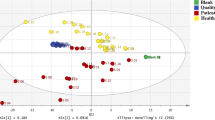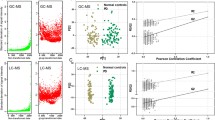Abstract
Although the phenylalanine/tyrosine ratio in blood has been the gold standard for diagnosis of phenylketonuria (PKU), the disadvantages of invasive sample collection and false positive error limited the application of this discriminator in the diagnosis of PKU to some extent. The aim of this study was to develop a new standard with high sensitivity and specificity in a less invasive manner for diagnosing PKU. In this study, an improved oximation-silylation method together with GC/MS was utilized to obtain the urinary metabolomic information in 47 PKU patients compared with 47 non-PKU controls. Compared with conventional oximation-silylation methods, the present approach possesses the advantages of shorter reaction time and higher reaction efficiency at a considerably lower temperature, which is beneficial to the derivatization of some thermally unstable compounds, such as phenylpyruvic acid. Ninety-seven peaks in the chromatograms were identified as endogenous metabolites by the National Institute of Standards and Technology (NIST) mass spectra library, including amino acids, organic acids, carbohydrates, amides, and fatty acids. After normalization of data using creatinine as internal standard, 19 differentially expressed compounds with p values of <0.05 were selected by independent-sample t test for the separation of the PKU group and the control group. A principal component analysis (PCA) model constructed by these differentially expressed compounds showed that the PKU group can be discriminated from the control group. Receiver-operating characteristic (ROC) analysis with area under the curve (AUC), specificity, and sensitivity of each PKU marker obtained from these differentially expressed compounds was used to evaluate the possibility of using these markers for diagnosing PKU. The largest value of AUC (0.987) with high specificity (0.936) and sensitivity (1.000) was obtained by the ROC curve of phenylacetic acid at its cutoff value (17.244 mmol/mol creatinine), which showed that phenylacetic acid may be used as a reliable discriminator for the diagnosis of PKU. The low false positive rate (1-specificity, 0.064) can be eliminated or at least greatly reduced by simultaneously referring to other markers, especially phenylpyruvic acid, a unique marker in PKU. Additionally, this standard was obtained with high sensitivity and specificity in a less invasive manner for diagnosing PKU compared with the Phe/Tyr ratio. Therefore, we conclude that urinary metabolomic information based on the improved oximation-silylation method together with GC/MS may be reliable for the diagnosis and differential diagnosis of PKU.




Similar content being viewed by others
References
Pietz J, Kreis R, Rupp A, Mayatepek E, Rating D, Boesch C, Bremer HJ (1999) Large neutral amino acids block phenylalanine transport into brain tissue in patients with phenylketonuria. J Clin Invest 103:1169–1178
Khemir S, El Asmi M, Sanhaji H, Feki M, Jemaa R, Tebib N, Dhondt JL, Ben Dridi MF, Mebazaa A, Kaabachi N (2011) Phenylketonuria is still a major cause of mental retardation in Tunisia despite the possibility of treatment. Clin Neurol Neurosurg 113:727–730
Guthrie R, Susi A (1963) A simple phenylalanine method for detecting phenylketonuria in large populations of newborn infants. Pediatrics 32:338–343
González EC, Frometa A, Rio L, Castells E, Robaina MS, García SM, Licourt T, Arteaga AL, Martínez L (2009) Cuban neonatal screening of phenylketonuria using an ultramicro-fluorometric test. Clin Chim Acta 402:129–132
Schulze A, Mayatepek E, Hoffmann GF (2002) Evaluation of 6-year application of the enzymatic colorimetric phenylalanine assay in the setting of neonatal screening for phenylketonuria. Clin Chim Acta 317:27–37
Kok WT, Brinkman UA, Frei RW (1983) Rapid determination of phenylalanine and tyrosine in urine and serum by HPLC with electrochemical detection. J Pharm Biomed Anal 1:369–372
Mo XM, Li Y, Tang AG, Ren YP (2013) Simultaneous determination of phenylalanine and tyrosine in peripheral capillary blood by HPLC with ultraviolet detection. Clin Biochem 46:1074–1078
Pecce R, Scolamiero E, Ingenito L, Parenti G, Ruoppolo M (2013) Optimization of an HPLC method for phenylalanine and tyrosine quantization in dried blood spot. Clin Biochem 46:1892–1895
Kand’ár R, Záková P (2009) Determination of phenylalanine and tyrosine in plasma and dried blood samples using HPLC with fluorescence detection. J Chromatogr B Analyt Technol Biomed Life Sci 877:3926–3929
Tuchman M, McCann MT (1999) Phenylalanine and tyrosine quantification by stable isotope dilution liquid chromatography-mass spectrometry from filter paper blood spots. Clin Chem 45:571–573
Andrensek S, Golc-Wondra A, Prosek M (2003) Determination of phenylalanine and tyrosine by liquid chromatography/mass spectrometry. J AOAC Int 86:753–758
Chace DH, Sherwin JE, Hillman SL, Lorey F, Cunningham GC (1998) Use of phenylalanine-to-tyrosine ratio determined by tandem mass spectrometry to improve newborn screening for phenylketonuria of early discharge specimens collected in the first 24 hours. Clin Chem 44:2405–2409
Chace DH, Millington DS, Terada N, Kahler SG, Roe CR, Lindsay F, Hofman LF (1993) Rapid diagnosis of phenylketonuria by quantitative analysis for phenylalanine and tyrosine in neonatal blood spots by tandem mass spectrometry. Clin Chem 39:66–71
Prinsen HC, Holwerda NE, Sain MG, Visser G, Verhoeven NM (2013) Reliable analysis of phenylalanine and tyrosine in a minimal volume of blood. Clin Biochem 46:1272–1275
Hardy DT, Hall SK, Preece MA, Green A (2002) Quantitive determination of plasma phenylalanine and tyrosine by electrospray ionization tandem mass spectrometry. Ann Clin Biochem 39:73–75
Walker V, Clayton BE, Ersser RS, Francis DE, Lilly P, Seakins JW, Smith I, Whiteman PD (1981) Hyperphenylalaninaemia of various types among three quarters of a million neonates tested in a screening programme. Arch Dis Child 56:759–764
Zschocke J, Carson DJ (1995) Transient neonatal hyperphenylalaninaemia is not related to mutations at the phenylalanine hydroxylase gene. J Inher Metab Dis 18:369–370
Reilly AA, Bellisario R, Pass KA (1998) Multivariate discrimination for phenylketonuria (PKU) and non-PKU hyperphenylalaninemia after analysis of newborns’ dried blood-spot specimens for six amino acids by ion-exchange chromatography. Clin Chem 44:2317–2326
Kawana S, Nakagawa K, Hasegawa Y, Yamaguchi S (2010) Simple and rapid analytical method for detection of amino acids in blood using blood spot on filter paper, fast-GC/MS and isotope dilution technique. J Chromatogr B Analyt Technol Biomed Life Sci 878:3113–3118
Kuhara T, Ohse M, Inoue Y, Shinka T, Okano Y, Shintaku H, Hongou K, Miyawaki T, Morinobu W, Tamai H, Omura K (2009) Urinary metabolic profile of phenylketonuria in patients receiving total parenteral nutrition and medication. Rapid Commun Mass Spectrom 23:3167–3172
Deng C, Yin X, Zhang L, Zhang X (2005) Development of microwave-assisted derivatization followed by gas chromatography/mass spectrometry for fast determination of amino acids in neonatal blood samples. Rapid Commun Mass Spectrom 19:2227–2234
Deng C, Li N, Zhang X (2004) Rapid determination of amino acids in neonatal blood samples based on derivatization with isobutyl chloroformate followed by solid-phase microextraction and gas chromatography/mass spectrometry. Rapid Commun Mass Spectrom 18:2558–2564
Sarkissian CN, Scriver CR, Mamer OA (2000) Measurement of phenyllactate, phenylacetate, and phenylpyruvate by negative ion chemical ionization-gas chromatography/mass spectrometry in brain of mouse genetic models of phenylketonuria and non-phenylketonuria hyperphenylalaninemia. Anal Biochem 280:242–249
Deng C, Deng Y, Wang B, Yang X (2002) Gas chromatography-mass spectrometry method for determination of phenylalanine and tyrosine in neonatal blood spots. J Chromatogr B Analyt Technol Biomed Life Sci 780:407–413
Deng CH, Shang CQ, Hu YM, Zhang XM (2002) Rapid diagnosis of phenylketonuria and other aminoacidemias by quantitative analysis of amino acids in neonatal blood spots by gas chromatography-mass spectrometry. J Chromatogr B 775:115–120
Thompson RM, Belanger BG, Wappner RS, Brandt IK (1975) An artifact in the gas chromatographic analysis of urinary organic acids from phenylketonuric children: decarboxylation of the phenylpyruvic acid during extraction. Clin Chim Acta 61:367–374
Paik MJ, Eun YC, Kim H, Kim KR, Choi S, Ahn YH, Lee G (2008) Simultaneous clinical monitoring of lactic acid, pyruvic acid and ketone bodies in plasma as methoxime/tert-butyldimethylsilyl derivatives by gas chromatography–mass spectrometry in selected ion monitoring mode. Biomed Chromatogr 22:450–453
Paik MJ, Kim KR (2004) Sequential ethoxycarbonylation, methoximation and tert-butyldimethylsilylation for simultaneous determination of amino acids and carboxylic acids by dual-column gas chromatography. J Chromatogr A 1034:13–23
Zhang D, Li W, Zhang J, Tang W, Qian C, Feng M, Chu Q, Ye J (2011) Study on urinary metabolic profile of phenylketonuria by micellar electrokinetic capillary chromatography with dual electrochemical detection—potential clinical application in fast diagnosis of phenylketonuria. Anal Chim Acta 694:61–66
Antoshechkin AG, Zuyeva LA, Maximova LA (1988) Excretion of phenylpyruvic, 4-hydroxyphenylpyruvic and indolyl-3-acetic acids by the skin fibroblasts from a phenylketonuric child. J Inherit Metab Dis 11:299–301
Hoffman NE, Gooding KM (1969) Gas chromatography of some urinary acid metabolites related to phenylketonuria. Anal Biochem 31:471–479
Wadman SK, Heiden CV, Ketting D, Sprang FJ (1971) Abnormal tyrosine and phenylalanine metabolism in patients with tyrosyluria and phenylketonuria; gas-liquid chromatographic analysis of urinary metabolites. Clin Chim Acta 34:277–287
Chalmers RA, Watts RW (1974) Quantitative studies on the urinary excretion of unconjugated aromatic acids in phenylketonuria. Clin Chim Acta 55:281–294
Vavich JM, Howell RR (1971) Rapid identification and quantitation of urinary metabolites of phenylalanine in phenylketonuria by gas chromatography. Transl Res 77:159–167
Jellum E, Horn L, Thoresen O, Kvittingen EA, Stokke O (1986) Urinary excretion of N-acetyl amino acids in patients with some inborn errors of amino acid metabolism. Scand J Clin Lab Inv 184:21–26
Endo F, Katoh H, Yamamoto S, Matsuda I (1991) A murine model for type III tyrosinemia: lack of immunologically detectable 4-hydroxyphenylpyruvic acid dioxygenase enzyme protein in a novel mouse strain with hypertyrosinemia. Am J Hum Genet 48:704–709
Tomoeda K, Awata H, Matsuura T, Matsuda I, Ploechl E, Milovac T, Boneh A, Scott R, Danks DM, Endo F (2000) Mutations in the 4-hydroxyphenylpyruvic acid dioxygenase gene are responsible for tyrosinemia type III and hawkinsinuria. Mol Genet Metab 71:506–510
Youmans JB (1938) A clinical study of pyruvic acid metabolism with special reference to vitamin B1 deficiency. Trans Am Clin Climatol Assoc 54:141–151
Haynes FW, Weiss S (1940) Responses of the normal heart and the heart in experimental vitamin B1 deficiency to metabolites (pyruvic acid, lactic acid, methyl glyoxal, glyceraldehyde, and adenylic acid) and to thiamin. Am Heart J 20:34–61
Acknowledgments
This work was supported by the Clinical Institute of Hunan Province for Inherited Metabolic disorders. This work was financially supported by Hunan Department of Science and Technology (2013XC83-11 and 2014SK4044).
Conflict of interest
The authors declare that they have no competing interests.
Author information
Authors and Affiliations
Corresponding author
Additional information
Xiyue Xiong and Xiaoqi Sheng contributed equally to this work.
Electronic supplementary material
Below is the link to the electronic supplementary material.
ESM 1
(PDF 98 kb)
Rights and permissions
About this article
Cite this article
Xiong, X., Sheng, X., Liu, D. et al. A GC/MS-based metabolomic approach for reliable diagnosis of phenylketonuria. Anal Bioanal Chem 407, 8825–8833 (2015). https://doi.org/10.1007/s00216-015-9041-3
Received:
Revised:
Accepted:
Published:
Issue Date:
DOI: https://doi.org/10.1007/s00216-015-9041-3




